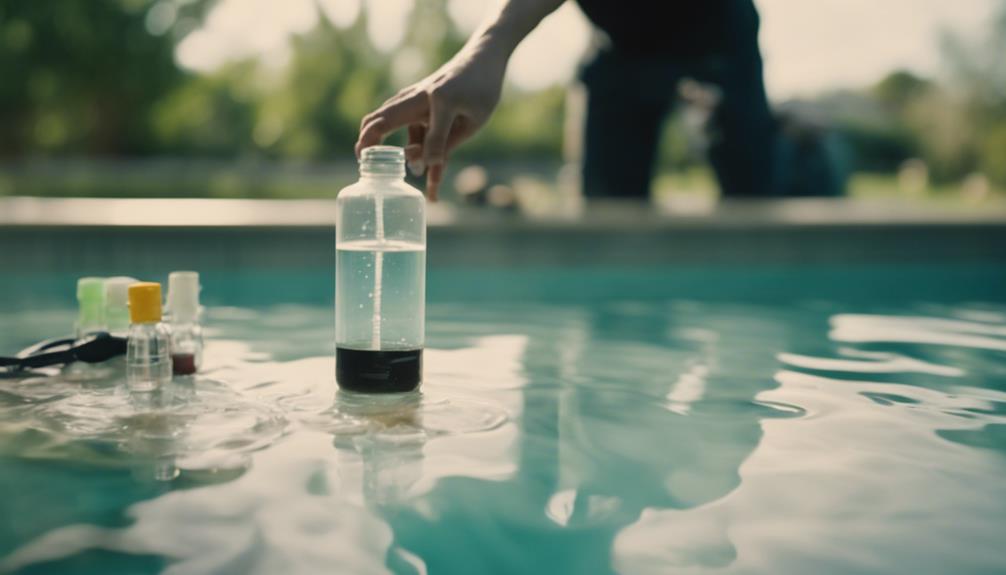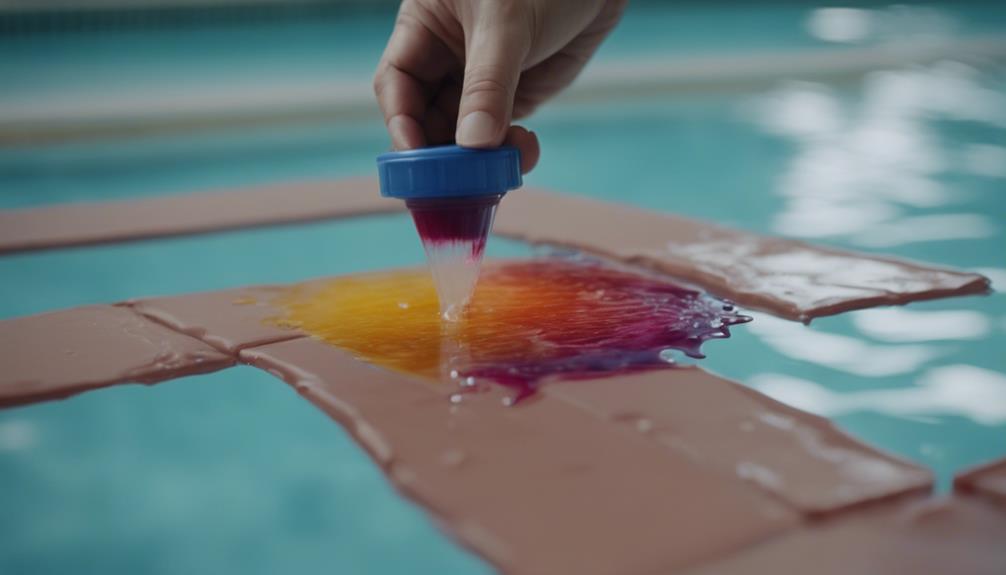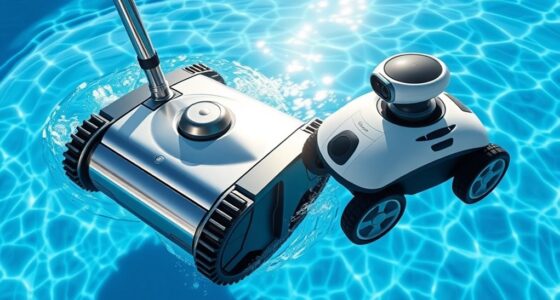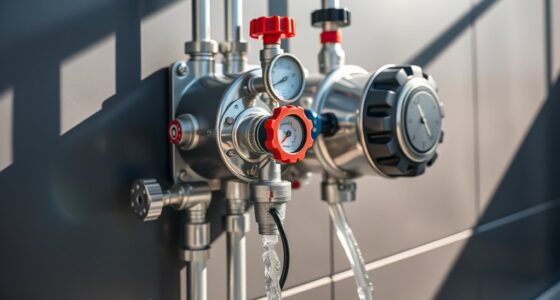If you suspect your pool is leaking, keep an eye out for wet spots, unusual water movements, or cracks in the pool structure. Look out for an increased chemical demand, such as frequent chlorine additions. Check for algae growth and stagnant water. Monitor your yard for ground settlement or excessive algae. Inspect the equipment area for spraying water, inspect the pool shell and plumbing. Perform a test with a bucket or dye test to confirm leaks. Taking immediate action can help prevent water loss and costly repairs. Stay alert for early detection to keep your pool healthy. More information on leak detection methods and repair solutions is available.
Key Takeaways
- Look for wet spots around the pool area as signs of leaks.
- Conduct a bucket test to detect significant water level drops.
- Inspect equipment area for ground moisture indicating hidden leaks.
- Hire professionals for accurate leak detection services.
- Address leaks promptly to prevent water loss and costly repairs.
Signs of Pool Water Loss
If you suspect your pool is leaking, there are several signs to watch out for to confirm your suspicions. Keep an eye out for wet spots in the yard, especially around the pool area. Standing water where it shouldn't be is a critical flag for potential leaks. Water near the pool that isn't from splashing or evaporation could indicate a leak.
Additionally, observe any unusual water movement, as this could suggest a problem with the pool's structure. Check the ground and walls for signs of a leak, such as cracks or shifting tiles.
To detect a leak, you can also use dye specifically designed for pool leak detection. Drop the dye into the water near where you suspect the leak might be and observe if it gets pulled towards a certain area, indicating a leak.
If you notice any of these signs, it's essential to take action promptly to repair the pool and prevent further water loss.
Increased Chemical Demand

An indication that your pool might be leaking is an increase in chemical demand, which can disrupt the water balance and lead to frequent additions of chlorine to maintain proper levels.
When there's a leak in your pool, contaminants can seep in, causing a dilution of the water and making it harder to maintain water quality. This influx of impurities can throw off the chemistry of the pool, resulting in the rapid depletion of chemicals like chlorine.
If you notice unexplained fluctuations in your chemical readings despite your regular maintenance efforts, it could be a sign that a leak is causing the imbalance. Continuous adjustments in chemical dosages without improvement may also signal a leak compromising the effectiveness of your treatments.
It's essential to address pool leaks promptly to avoid ongoing chemical imbalances and the challenges associated with maintaining water quality. Regularly monitoring your pool's chemical levels can help you detect leaks early and prevent further issues with water balance.
Structural Pool Issues

If you notice cracks in your pool shell, falling tiles, or gaps in the bond beam, these could be signs of structural pool issues.
Untreated leaks can lead to ground settlement around your pool, potentially causing further damage to its foundation.
Keep an eye out for uneven ground, landscaping erosion, or excessive algae growth, as these could also indicate underlying structural problems that need immediate attention.
Cracks and Leaks
Dealing with cracks in your pool's structure can lead to leaks and potential water loss, posing challenges for maintenance and increasing the risk of damage. Pool leaks resulting from structural damage such as cracks not only affect your water bill but also create an environment conducive to algae growth and bacterial contamination. It is important to address these issues promptly to prevent further damage and costly repairs. Seeking professional assistance is recommended for accurately diagnosing and repairing structural pool leaks. Take into account the following factors when dealing with cracks and leaks in your pool:
| Factors to Take into Account | |
|---|---|
| Pool Leaks | Cracks in the pool structure can result in leaks, leading to water loss and potential damage. |
| Algae Growth | Structural damage can create an ideal environment for algae growth, necessitating timely repair. |
| Professional Assistance | Seeking help from professionals is essential for accurately diagnosing and repairing structural pool issues. |
Foundation Problems
Addressing foundation problems in your pool is essential for ensuring structural integrity and preventing potential leaks. When dealing with foundation issues in your pool, keep in mind the following:
- Cracks in the pool structure or falling tiles can indicate serious structural damage that needs immediate attention.
- Watch out for signs of unsettled ground around the pool and gaps in the bond beam, as these can lead to further problems with the pool structure.
- Ground settlement can result in landscaping erosion, uneven grass, and soft spots near the pool, indicating underlying foundation issues.
- Remember that structural damage from pool leaks can lead to costly repairs and impact the overall integrity of your pool. Seeking a professional assessment is vital to accurately diagnose and address any foundation problems to maintain the structural stability of your pool.
Algae Growth Concerns

If you spot green, slimy patches in your pool, it could signal a leak contributing to algae growth. Algae thrive in water with imbalanced chemicals, often caused by leaks, making it essential to address the issue promptly.
Keeping algae at bay involves proper identification, prevention methods, and effective treatment to maintain a clean and leak-free pool environment.
Algae Identification Tips
Detecting algae in your pool can provide valuable clues about potential water leakage issues. Here are some tips to help you identify algae growth:
- Appearance: Different types of algae may manifest as green, black, or yellow discoloration on pool surfaces, indicating a potential leak.
- Texture: Algae can create slippery or slimy areas in your pool, making it unsafe for swimming and signaling a disturbance in the chemical balance.
- Smell: A musty or unpleasant odor near the pool could be a sign of algae growth, which can worsen with warm temperatures and sunlight exposure.
- Water Clarity: Cloudy or murky water, often caused by algae proliferation, hints at a leak affecting the pool environment.
Preventing Algae Growth
To prevent algae growth in your pool, maintaining proper water circulation and chemical balance is vital. Algae growth can be a sign that your pool is leaking, as leaks disrupt the chemical balance and create a breeding ground for algae.
The stagnant water resulting from pool leaks provides an ideal environment for algae to thrive. Hence, prompt leak detection and repair are essential in preventing algae growth. Addressing leaks promptly not only maintains proper water circulation but also guarantees the chemical balance isn't compromised, reducing the risk of algae infestations.
By regularly monitoring and maintaining your pool's water chemistry and promptly addressing any leaks, you can effectively prevent algae growth. Remember, a well-circulated and chemically balanced pool not only looks inviting but also keeps algae at bay.
Stay proactive in leak detection and repair to enjoy a clean and algae-free swimming experience.
Treating Algae Infestations
Addressing algae infestations promptly is key to maintaining a clean and safe swimming environment in your pool. When it comes to treating algae growth, there are several essential steps to take into account:
- Prompt Leak Detection: Algae growth often signals a leak, emphasizing the importance of identifying and repairing leaks promptly to prevent further water imbalance.
- Balancing Water Chemistry: Maintaining proper water balance is vital for preventing algae outbreaks and ensuring a healthy pool environment.
- Thorough Cleaning of Pool Surfaces: Scrubbing and brushing pool surfaces regularly can help eliminate existing algae and prevent it from spreading.
- Preventing Equipment Damage: Algae can clog filters and damage pool equipment, underscoring the need for regular maintenance to keep your pool functioning properly.
Yard Wet Spots

If you notice wet spots in your yard near the pool, it is essential to be vigilant as it could be a sign of a potential leak in the plumbing or pool structure. These wet areas might not only indicate a leak in your pool but can also lead to water loss, landscaping issues, erosion, and even structural damage over time. Regularly checking for wet spots around your pool is vital to detect leaks early and prevent further damage. Addressing these wet areas promptly can help minimize water loss, avoid costly repairs, and maintain a healthy pool environment. To assist you in understanding the implications of yard wet spots, here is a table outlining the possible consequences and actions you can take:
| Issue | Potential Impact | Recommended Action |
|---|---|---|
| Plumbing Leak | Increased water loss and structural damage | Contact a pool maintenance expert |
| Pool Structure | Risk of further damage and compromised safety | Schedule an inspection |
| Landscaping | Erosion, damage to plants, and aesthetic issues | Re-evaluate landscaping design |
| Water Loss | Higher utility bills and environmental impact | Monitor water levels regularly |
| Structural Damage | Safety hazards and expensive repairs | Seek professional assistance |
Rising Water Bills

If you notice a sudden surge in your water bill, it could be a sign of a pool leak causing high water consumption.
Keep a close watch for unexplained water loss reflected in your bills, as undetected leaks can lead to increased expenses over time.
Investigating rising water bills promptly can help you pinpoint and address potential pool leaks before they become a financial burden.
High Water Consumption
Monitoring your water bills for unexplained increases can signal a potential pool leak that needs immediate attention. High water consumption leading to rising water bills could be indicative of a pool leak. Consider the following to understand the impact of abnormal spikes in water usage related to pool leaks:
- Financial Strain: Rising water bills due to pool leaks can strain your finances, increasing overall utility costs.
- Environmental Impact: Continuous water loss from pool leaks contributes to water wastage, impacting the environment.
- Property Damage: Pool leaks can cause structural issues, leading to costly repairs if left unaddressed.
- Preventive Action: Promptly investigating and fixing pool leaks can prevent further damage, reduce water wastage, and lower utility costs over time.
Be vigilant for wet spots or signs of structural issues around your pool area, as they may indicate a leak. Addressing pool leaks promptly not only saves you money but also helps conserve water and maintain your property's integrity.
Unexplained Water Loss
To detect a potential pool leak causing rising water bills, be attentive to unexplained water loss in your pool. If you notice that your pool is losing water at a faster rate than usual or without any apparent reason, it could be a sign of a potential pool leak.
Monitoring your water levels and tracking water usage can help you detect unexplained water loss. Rising water bills, especially when there hasn't been an increase in water usage, may indicate a pool leak that needs addressing promptly.
Ignoring unexplained water loss can lead to further damage and potentially costly repairs down the line. In such cases, it's advisable to contact professional pool leak detection services. These experts can accurately identify and repair any leaks that are causing the rising water bills, ultimately saving you from unnecessary expenses and preserving the integrity of your pool.
Equipment Area Water

Inspect the equipment pad for leaks by checking the filter, pump, heater, and valves for any signs of spraying water. Ground moisture around the equipment area could suggest hidden leaks that might be causing water loss in your pool. Significant water loss from your pool might indicate a major leak stemming from the equipment area.
Even small drips at the equipment pad shouldn't be overlooked, as they've the potential to develop into larger issues over time. Be attentive to any visible leaks or signs of water loss near your pool equipment to prevent further damage and maintain the integrity of your pool system.
Addressing leaks promptly can save you money on potential repairs in the long run.
Ignoring small leaks may lead to more significant issues with your pool equipment.
Regularly inspecting the equipment area can help you catch leaks early and prevent water loss.
Taking proactive measures to fix leaks promptly will help keep your pool in good condition.
Testing for Pool Leak

Check for pool leaks by conducting a bucket test to compare water levels and using a dye test near potential leak areas to detect any signs of water loss.
To perform a bucket test, fill a bucket with pool water and mark the water level inside it. Place the bucket at the pool's edge, ensuring it's immersed in water. After 24 hours, compare the water levels inside the bucket and the pool. If the pool water level drops more than the bucket, it may indicate a leak.
Additionally, conduct a dye test by adding dye near suspected leak areas; if the dye gets pulled into a crack or hole, there might be a leak present.
Remember to monitor water levels regularly, looking for any significant drops that could signify a leak.
For more accurate results, consider hiring professional pool leak detection services that may utilize pressure testing to detect underground leaks effectively.
Identifying Leak Source

Identify the source of the pool leak by conducting a thorough examination of the pool shell, plumbing system, equipment pad, and skimmers.
To pinpoint the exact location of the leak, consider using a dye test to visualize where the water is escaping.
Look for wet areas around the pool that could indicate a potential leak source. Additionally, stabilizing water levels can help narrow down the location of the leak.
Utilize a pressure test on underground plumbing to detect hidden leaks that may be affecting your pool.
Remember, professional pool service providers have specialized techniques and equipment to accurately identify the source of the leak.
If you suspect a leak near the pool pump or in the plumbing system, don't delay in addressing it to prevent further damage and costly repairs.
Professional Pool Service

Consider enlisting the expertise of professional pool services for accurate leak detection and specialized repair solutions. When faced with a potential leak in your pool, these experts can employ advanced leak detection techniques to pinpoint the source of the issue.
By seeking expert assistance, you can guarantee that any necessary repairs are carried out effectively, preventing further damage. Professional pool technicians possess the knowledge and skills to diagnose and repair pool leaks efficiently, offering long-lasting fixes and preventive measures to maintain your pool's integrity over time.
Their specialized repair solutions are tailored to address the specific needs of your pool, ensuring that the problem is resolved correctly. Investing in professional pool services not only saves you time and hassle but also helps to safeguard the condition of your pool for the future.
Trusting the expertise of these professionals can provide you with peace of mind knowing that your pool is in good hands.
Frequently Asked Questions
How to Tell if a Pool Main Drain Is Leaking?
To determine if a pool main drain is leaking, observe excessive water loss from the drain or any wet spots near it.
Monitor the water level around the main drain for irregularities.
Perform a dye test around the drain to locate the leak accurately.
If you suspect a leak, contact a professional pool service for precise detection and repair.
Proper maintenance and early detection can prevent further damage to your pool.
Can You Fix a Pool Leak Without Draining?
You can indeed fix a pool leak without draining it. Utilize underwater repair materials like waterproof tape, peel-and-stick patches, or vinyl patch kits.
Choosing the appropriate method based on the leak's size and location is essential. Professional repair guides offer step-by-step instructions for efficient leak repairs without draining the pool.
Specialized techniques and materials designed for underwater repairs can address pool leaks effectively without the need to drain the pool.
How Do I Know if My Pool Return Line Is Leaking?
To determine if your pool return line is leaking, watch for air bubbles in the return line or water pooling around it. Monitor the water level closely, especially when the pump is running.
Conduct a dye test by adding dye near the return line to detect any leaks. If unsure, consider hiring a professional for a pressure test.
Regular inspection and timely repairs can help prevent extensive damage caused by leaks in the pool return line.
Can a Pool Lose Water Without a Leak?
Yes, a pool can lose water without a leak. Factors like evaporation, splashing, and backwashing contribute to water loss.
Evaporation, influenced by temperature and humidity, can cause significant water loss, up to 1/4 inch per day or 2 inches per week.
Regular monitoring and conducting a bucket test help differentiate between normal water loss and leaks.
If water loss exceeds typical evaporation rates, it may indicate a leak requiring professional inspection and repair.
How Can I Determine If My Pool Is Leaking and What Can I Do to Fix It?
If you suspect a leak in your pool, look for common swimming pool leaks repair signs such as a drop in water levels, wet spots around the pool, or constantly running pump. Consider hiring a professional to locate and fix the leak, whether it’s a cracked pipe, damaged pool liner, or faulty skimmer.
Conclusion
To sum up, if you suspect your pool is leaking, it's crucial to carefully monitor for signs of water loss and take action promptly.
By identifying the source of the leak and seeking professional pool service, you can address the issue effectively and prevent further damage.
Remember, early detection is key to maintaining the integrity of your pool and enjoying a worry-free swimming experience.
Don't delay in addressing a potential leak to guarantee the longevity of your pool.










